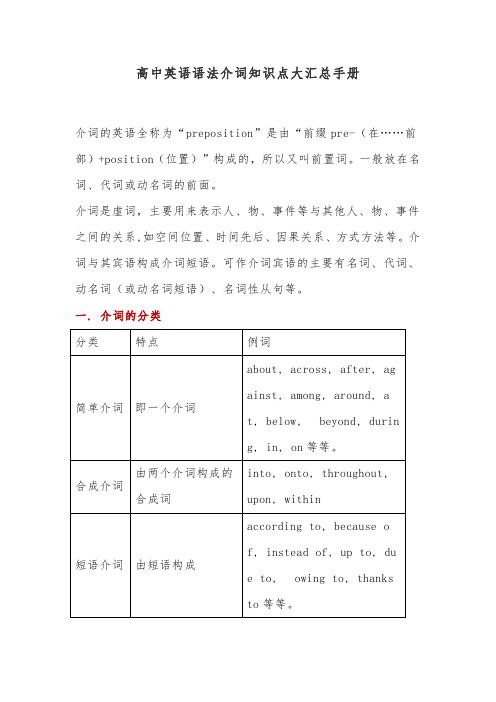英语语法手册—介词篇
- 格式:docx
- 大小:19.99 KB
- 文档页数:9

高中英语语法介词知识点大汇总手册介词的英语全称为“preposition”是由“前缀pre-(在……前部)+position(位置)”构成的,所以又叫前置词。
一般放在名词、代词或动名词的前面。
介词是虚词,主要用来表示人、物、事件等与其他人、物、事件之间的关系,如空间位置、时间先后、因果关系、方式方法等。
介词与其宾语构成介词短语。
可作介词宾语的主要有名词、代词、动名词(或动名词短语)、名词性从句等。
一.介词的分类分类特点例词简单介词即一个介词about,across,after,ag ainst,among,around,a t,below,beyond,durin g,in,on等等。
合成介词由两个介词构成的合成词into,onto,throughout, upon,within短语介词由短语构成according to,because o f,instead of,up to,du e to,owing to,thanks to等等。
双重介词由两个介词搭配而成from among,from behind, from under,till after, in between等等。
分词介词由现在分词转化而来considering(就……而论), including,regarding,c oncerning等。
兼类介词由形容词直接转化而来like,unlike,near,nex t,opposite等等。
二.介词短语的语法功能介词不能独立在句中做成份,介词后必须与名词、代词、或动名词构成介词短语在句中充当一个成分,表示人、物、事件等与其它人、物、事件等之间的关系。
介词短语的功能例句作定语They didn’t find the solution to the problem.作状语We have breakfast at seven.(表时间)They were late for the meeting because of the heavy rain.(表原因)What do you mean by doing such athing?(表方法)Nothing in the world could live without air or water.(表条件)作表语When I paid a visit to you yesterday,you were not at home.作宾语补足语I found the old building in a badcondition.三.表示相同或相似概念的介词(短语)的区别表示的概念介词(短语)区别例子时间in on atat在一个时间点上;in在一段时间之内;on在具体某一天或具体的上午、下午、晚上。


初中英语语法专题—介词讲解介词的基本定义介词是一类独立的词性,用于连接名词、代词或者动词、形容词、副词等语境之间的关系。
在句子中,介词通常放在名词或代词之前,用来表达地点、时间、原因、方式等概念。
下面是一些常用的英语介词:- in- on- at- with- for- from介词在地点描述中的用法介词在描述地点时,可以用来表示具体位置、方向、距离等概念。
下面是一些常见的介词在地点描述中的应用:- in:用于表示在某个范围之内的位置,例如 "in the room"(在房间里),"in the park"(在公园里)。
- on:用于表示在表面、平台或者位置上的状态,例如 "on the table"(在桌子上),"on the bus"(在公交车上)。
- at:用于表示在某个具体位置或者地点,例如 "at the cinema"(在电影院),"at school"(在学校)。
- to:用于表示朝向某个位置的移动,例如 "go to the park"(去公园)。
介词在时间描述中的用法介词在描述时间时,可以用来表示具体时间、时间段等概念。
下面是一些常见的介词在时间描述中的应用:- at:用于表示具体的时间点,例如 "at 7 o'clock"(在7点钟)。
- on:用于表示具体的日期或者星期几,例如 "on Monday"(星期一),"on January 1st"(1月1日)。
- in:用于表示较长的时间段或者某一个时间段内,例如 "inthe morning"(早上),"in July"(在七月)。
介词在原因描述中的用法介词在描述原因时,可以用来表示某事的起因或者原因。

英语语法介词(集锦7篇)英语语法介词第1篇连词概述:连词是一种虚词,用于连接单词,短语或句子,但不单独做句子成分。
按照连词的性质,可将连词分为并列连词和从属连词。
并列连词如:and,but,or,for等,它们即可连接单词,短语,又可连接句子。
从属连词如:when,before ,because等,它们主要引导名词性从句。
常见连词的用法:1)并列连词的用法:并列连词有:and, but, or, nor, so, for yet, however, as well as, both…and, not only…but also, either…or, neither…nor, still,And:连接单词短语句子。
如:Tom and I study in the same But, or :I have a pen but no / Would you like coffee or tea? Nothing but除了,只有: I did nothing but watchOr表示否则:如: Hurry up or you will miss thefor 表示后面的句子是原因。
如: He is good at piano for he practices harder thanNot only…but also 不仅…而且。
可并列主、谓、宾、表及句子。
主语并列时,谓语要就近一致。
如: Not only he but also I am aAs well as 以及,同样。
并列单词、短语、句子。
并列主语时,动词要随前面的主语变化 .如:He works as well as he canEither…or 既…又…,或…或…,并列主、谓、宾、表及状语,如:Either come in or goNeither…nor 既不…也不,并列主、谓、宾、表、状语,并列主语时,谓语就近一致。
如:Neither you nor he isBoth…and 和,既…也,并列主、谓、宾及表语。

初中英语语法之介词初中英语语法大全之介词介词(preposition 简写prep.)又称作前置词,表示名词、代词等与句中其他词的关系,在句中不能单独作句子成分。
下面是店铺精心为大家整理的关于介词的初中英语语法知识,希望对大家有帮助!初中英语语法之介词篇1I介词的功能介词是一种虚词,用来表示名词或相当于名词的其它词语句中其它词的关系,不能单独使用。
介词可与名词或相当于名词的其它词构成介词短语。
介词短语可在句中作定语,状语,表语和宾语补足语。
例如:The boy over there is John’s brother. (定语)The girl will be back in two hours. (状语)Our English teacher is from Australia. (表语)Help yourself to some fish. (宾语补足语)II表示时间的介词表示“时间”的介词如下:1.表示年、月、日、时刻等用at,in,on2.表示时间的前后用 before, after3.表示期限等用by,until,till4.表示期间等用for,during,through5.表示时间的起点等用 from, since6.表示时间的经过等用in,within(1) at,on,in1)at:用于表示时刻、时间的某一点at noon正午时 at night在夜间 at present目前at nine(o’clock)在九点钟We usually have lunch at noon(at twelve).我们通常中午吃午饭(十二点吃午饭)。
(2)on:用于某天,某一天的上、下午(指具体的某一天时,一律用on)注意 :泛指一般的上午(下午)时用in,但特指某日的上午(下午)时用on。
in the morning在早上on sun day morning在周日早上on Monday在周一on Tuesday morning在周二早上on June 6在6月6日on May 4,1996在1996年5月4日on a cold night在一个寒冷的夜晚on the night of July(the) first在七月一日的夜晚We didn't listen to the lecture on Wednesday afternoon上周三下午我们没去听演讲。

初中英语语法介词介词在英文中是一种虚词,在英语里面的使用频率特殊高。
下面是学习啦我为你整理的初中英语的介词语法,希望大家宠爱!常用介词的用法1. 在的前面in front of (范围外的前面)in the front of (在范围内的前面)There is a river ________ my house.我家前面有一条河。
There is a blackboard ___ our classroom .教室前面有一块黑板。
2.在树上on the tree 强调树上长出的东西(苹果,橘子)in the tree 外来物体(人,鸟,风筝)There are some birds _____ the tree.树上有一些鸟。
There are some apples _______ the tree.树上有一些苹果。
3.时间表达:in + 某月/ 某季节/ 某年(时间长)on + 某天(中)at + 具体几点几分(短) 固定短语:in the morning / afternoon / evening at night, at noon练习:__January , __ summer, ___ 2021______ Sunday, ___ March 4th, ___ March___ _ Sunday morning,_____ the morning_______ the morning of June 5th_______ 6:30, ____ night, __ noon4.在墙上on the wall在墙壁外表(相片photo,图画picture)in the wall在墙壁的里面(门door, 窗户window )(1)There is a photo of my family_______ the wall.(2)There are two doors ______ the wall.5. 在之上on:在的外表之上(物体之间有接触)over: 在的正上方(物体没有接触)above 高于......;在......之上',多指在相对较高位置(1)There is a book ______ the desk.书桌上有一本书。
p. 233介词+名词词组at a loss∙不知所措He found himself at a loss for words of consolation.他简直想不出安慰的话来。
Mary is at a loss what to do next.玛丽不知道下一步该做什么。
∙ 2.亏本They must sell the goods at a loss.他们必须亏本出售商品。
At any rate无论如何At length∙ 1.充分地; 详尽地He went into the subject at full length.他详细地研究了这个问题。
Well, we have discussed the matter at length.这件事我们已经仔细讨论过了。
He talked at length about his work and his family.他详谈他的工作和家庭。
∙ 2.最后, 终于At length he returned.他最后还是回来了。
At length the young lady raised her head and looked steadily at his intelligent face.那个年轻妇女终于抬起头, 目不转睛地盯着他心领神会的脸。
by any means 用一切可能的方法或手段;无论如何by no means 决不一点也不by the way∙顺便地, 附带说说,顺便提一下,捎带说一声,附带问一句By the way, what time is it?顺便问一下, 现在几点了?for the time being, 目前暂时.from time to time, 有时不时.in no time, 立即马上.∙in any case无论如何, 不管怎样It may rain tomorrow, but we are going home in any case.明天可能下雨, 但不管怎样, 我们打算回家去。
小学英语语法详解介词——一些常见的的介词及其用法3)表手段、方式的介词by,in,with等。
①by+交通工具,指的是所用的交通方式。
by boat by train坐火车by taxi坐出租车by bus坐公共汽车by bike骑自行车by boat坐船by plane坐飞机②inThey paid in cash.他们用现金支付。
Can I speak in Chinese?我可以用中文说吗?Please read it in a high voice.请响亮地朗读。
③withWith the eyes,I can see.我用眼睛看。
I cut the apple with a sharp knife.我用一把锋利的刀削苹果。
Tom drew the picture with a pencil.汤姆用铅笔画画。
4)小学阶段的一些常见的介词及其用法①ofa. (属于)….的He is a friend of mine.他是我的一个朋友。
b.由....组成(或构成)This is a cake of sugar.这是一块糖做的蛋糕。
C.含有(或装有)…. 的A packet of biscuits please.请给我一包饼干。
d.表示数量或种类The tiger eats ten kilos of meat every day.老虎每天要吃十公斤肉。
e.由于、因为She died of illness.她是病死的。
of的一些重要词组* because ofHe left because of his fail.他因失败而离开。
* be afraid ofI am afraid of spiders.我害怕蜘蛛。
* a lot ofThere is a lot of sunshine.阳光很好。
* all kinds ofThere are all kinds of fruits in the basket.篮子里有各种水果。
英语语法:介词用法介词在英语语法当中是非常常用的一种语法结构,那么作为常用的语法我们该如何学好呢,下面就是小编给大家带来的英语语法:介词用法,希望能帮助到大家!介词的用法一:一、介词to的常见用法1.动词+toa)动词+ toadjust to适应,attend to处理;照料,agree to赞同,amount to加起来达…,belong to属于,come to达到,drink to为…干杯,get to到达,happen to发生在某人身上,hold to紧握,lead to通向,listen to听,occur to想起,object to反对,point to指向,respond to回答,refer to参考;指的是…;涉及,reply to回答,see to负责,stick to坚持,turn to求助,write to给某人写信。
b)动词(+sth.)+to+sb.announce to通知某人, describe to向某人描述, explain to 向某人解释, express to对某人表达, mention to提及, nod to向某人点头,report to报告,say to告知,shout to对某人大叫,suggest to对某人提建议,speak to与某人交谈,talk to跟某人谈话, whisper to和某人低声耳语。
c)动词+sth./sb.+ to +sth./sb.add to增加, compare to比作, carry to运送至, devote to 致力于,introduce to介绍给, invite to邀请参加, join to连接到,leave to委托给,reduce to下降至, sentence to判处, take to带到。
2. be +形容词/过去分词+ tobe alive to觉察;晓得,be attentive to注意;留心,be awake to知晓,be blind to缺乏眼光,be close to紧挨着,be common to对某人来说很普通,be contrary to违反;反对,be devoted to致力,be deaf to不愿意听,be equal to有…的力量,be exposed to暴露;遭受,be fair to对…公平,be familiar to对某人来说熟悉,be grateful to对某人心存感激,be good to对…有好处,be harmful to对…有危害,be important to对…重要,be kind to友好对待,be known to周知于,be married to嫁给,be moved to转移到,be near to靠近,be necessary to对…有必要,be opposite to在对面,be opposed to反对,be pleasant to合某人之意,be proper to专属,be polite to礼貌待人,be rude to粗暴对待,be relative to与…有关,be strange to不习惯,be similar to类似,be suitable to适合,be true to忠实,be thankful to感激,be useful to对…有用,be used to习惯。
英语语法手册—介词篇一、介词的主要用法:介词是一种虚词,不能独立使用。
介词之后一般有名词或代词(宾格)或相当于名词的其他词类、短语或从句作它的宾语,即构成介词短语。
有些介词是由两个以上的词构成的短语介词,如:out of(从…中出来),because of(因为), away from(距离…), on top of(在…顶上),ever since(自从…), next to(在…隔壁),according to(根据…), in front of(在…前方)等。
二、介词的分类表:(见下表)地点(位置、范围)介词:above在…前, about在…附近, across在…对面, after在…后面, against倚着...,along在…近旁,among在…中间,around在…周围,round在….周围, at 在…处, before在...前, behind在...后, below低于...,beside在...旁边,between 在...之间,by在...旁,down在...下面,from来自..., in在...里面,inside在...里面,near靠近..., of在...之中,on在...上面,out of在...之外,outside在....外面,over 在....上方,under在...下方,up在...上面, on top of在...顶部, infront of在...前, close to靠近...,in the middle of在...的中间,at the end of在...的末端,等等。
方向(目标趋向)介词:across横越...,against对抗..., along沿着..., around绕着...,round环绕..., at朝着..., behind向…后面, etween…and…从…到...,by路过/通过..., down向…下, for向...,from从/离...,in进入..., into进入..., inside到...里面, near接近...,off脱离/除...,on向...上,out of向...外,outside向....外,over跨过..., past经过/超过...,through穿过..., to向/朝...,towards朝着..., on to到...上面,onto到...上面,up向...上,away from远离...时间介词:about大约...,after在…以后,at在…(时刻),before在…以前,by到…为止,during 在…期间,for有…(之久),from从…(时)起, in在(上/下午);在(多久)以后, on在(某日), past过了…(时), since自从…(至今), through 贯穿…(期间), till直到…时, until直到…时, to到(下一时刻), ever since从那时起至今,at the beginning of 在...开始时,at the end of在...末, in the middle of在...当中,at the time of 在...时方式介词:as作为/当作..., by用/由/乘坐/被..., in用…(语言), like与…一样,on骑(车)/徒(步),通过(收音机/电视机), over通过(收音机), through通过...,with用(材料),用(手/脚/耳/眼), without没有…涉及介词:about关于...,except除了…, besides除了…还...for对于/就…而言, in在…(方面), of…的,有关..., on关于/有关..., to对…而言, towards针对...,with就…而言其它介词:[目的介词] for为了..., from防止…, to为了…[原因介词] for因为..., with由于…, because of因为...[比较介词] as与…一样,like象…一样,than比...,to与…相比,unlike与…不同[伴随/状态介词]against和…一起(比赛),at在(上班/休息/上学/家,etc.),in穿着…(衣服/颜色),into变成...,on在(值日),with与…一起,有/带着/长着..., without没有/无/不与…一起三、介词短语的句法作用:介词短语相当于一个形容词或副词,可用作状语、定语和表语。
如:The man came <down the stairs>.(状)(那个人走下楼来)The woman <with a flower on herhead> is from the countryside.(定)(头上戴花的妇女来自乡下)The teacher is now with the pupils.(表)(老师现在和学生在一起)四、介词短语在句子中的位置:介词短语做状语时,如果表示时间/地点,可以放在句首或句尾,如果表示方向/方式/伴随/涉及/原因/目的/比较,一般放在句尾;介词短语作表语时放在连系动词之后;介词短语作定语时,只能放在被修饰的名词之后。
如:He wanted to find a good job in Shanghai the next year.(状语)(他想来年在上海找份好工作)They searched the room for the thief.(他们在房间里搜索小偷)The letters are foryou.(表语)(信是给你的)Have you seen a cat with a black head and four white legs?(定语)(你看见一只黑头白腿的猫了吗?)五、重要注释:1、this / that / these / those / last / next / a /every / each等词构成的时间短语,前面不用任何介词。
如:Every year travellers from abroad come tovisit Pingyao.(每年都有国外的游客来游览平窑镇)He had a bad cold thatweek.(那个星期他患重感冒)2、for有时用来引出动词不定式的逻辑主语,常翻译成“对于…而言”。
如:It’s too hard for me tofinish the work in only one hour.(让我在区区一个小时内完成这项工作太难了)The house is big enough for 10 men to live in.(房子够大的可以容10个人住)3、of有时用来表示后面的人物正好是前面的表语的逻辑主语。
如:It’s very nice/kind of you to do so.(你这么做真是太好了)4、介词有时会与它的宾语分离,而且宾语前置。
①当宾语是疑问词时。
Who are you talking about?(你们在谈论谁?)②宾语在从句中当连接词时。
He has a younger brother who he must take good care of.(他有一个需要他照顾的小弟。
)Do you know who our teacher is talking withover there?(你知道我们的老师在那边和什么人谈话吗?)③动词不定式作定语且该动词为不及物动词,后面有介词。
I finally found a chair to siton.(我最终找到了一张椅子坐。
)=5、记住一些固定词组:arrive at/in(到达…),on foot(步行),not…at all(根本不),to the north of(在…以北),inthe east of(在…的东部),inthe night(在夜间),at night(在晚上),be afraid of(害怕…),be full of(充满/ 装满….),befilled with(充满/ 装满….),begood/bad for(对…有益/有害),be made of(由…做成),bemade from(由…制造),playwith(玩耍……),look out of(朝…外面看),atthe end of(在…末梢/结束时),by the end of(不迟于…/到…末为止),with the help of或with one’s help(在…的帮助下),look after(照料…),look for(寻找…),on a bike(=by bike)骑车, help sb. with(帮某人做…),get on (well) with(与某人相处[融洽]),等等。
六、某些介词的用法辨析:1、时间或地点介词in、on、at的用法区别:表示时间时, in表示在一段时间里(在将来时句子中则表示在一段时间之后), on表示在具体的某一天或者某天的上下午等, at表示在某个时刻或者瞬间;表示地点时,in表示在某个范围之内, on 表示在某个平面上或与一个面相接触,at则表示在某个具体的场所或地点。
如:He was born on the morning ofMay 10th.(他出生于五月十日的早晨)I usually get up at 7:00 in the morning.(我通常在早上的七点钟起床)His glasses are right on his nose.(他的眼镜就架在他的鼻子上)He is at the cinema at themoment.(此刻他正在电影院)2、after与in表示时间的用法区别:“after+(具体时刻/从句)”表示“在…时刻之后”常用于一般时态;“in+(一段时间)”表示“在(多久)之后”,常用于将来时态。
如:He said that he would be here after 6:00.(他说他六点钟之后会来这儿) My father is coming back from England in about a month.(我父亲大约一个月以后从英国回来)3、since与for表示时间的用法区别:“since+(具体时刻/that-从句)”表示“自从…起一直到现在”,“for +(一段斶间)”表示“总共有…之久”,都常用于完成时态;如:Uncle Li has worked in thisfactory since 1970.(李叔叔自从1970年起就在这家工厂工作了)Uncle Li has worked in this factory for over 30 years.(李叔叔在这家工厂已经工作了30多年)4、by、in与with表示方式的用法区别:都可以表示“工具、手段”,但是by 主要表示“乘坐”某个交通工具或“以……方式”,在被动句中可以表示动作的执行者;in表示“使用”某种语言/文字,with表示“使用”某个具体的工具、手段。